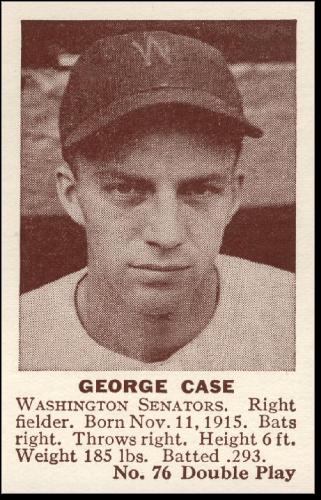
Sport: Baseball
Born: November 11, 1915
Died: January 23, 1989
Town: Trenton, New Jersey
George Washington Case was born November 11, 1915, in Trenton, NJ. A good all-around athlete, what set George apart from the other boys was his raw speed. He attended the Peddie School in Hightstown, an institution that placed high standards on its students and athletes. George entered the school a year later than most boys. He soon became the star of the basketball and baseball teams.
On the hardwood, George led the Gold and Blue in scoring in every varsity game he played. On the diamond, he had an explosive fastball. George pitched and played the outfield for Peddie. Though not known as a slugger as a big leaguer, he hit a home run against every team Peddie played one season.
The Washington Senators had a farm team in York, PA in 1936, the year George graduated. They moved to Trenton during that season and signed George, the star local product. In a little over a year, he got his first taste of big-league action, playing in 22 games with Washington at the age of 21.
From 1938 to 1945, George was a fixture in the Senators’ outfield. He was also the fastest man in the American League, leading the AL in stolen bases five years in a row. In an era when base-stealing was not in vogue, he put up eye-popping totals, including 51 in 1939 and 61 in 1943. Not surprisingly, he led the league in runs scored in 1943. Most years George reached triple-digits in runs scored and his average was right around .300. As an outfielder there was little that eluded him.
George made a science of base-stealing, learning to spot clues from AL pitchers and catchers that indicated the ideal time to take off. After retiring, he said that the easiest catcher to steal against was fellow New Jerseyan Frankie Hayes. The toughest was Paul Richards. For his career, George was successful on 76 percent of his attempts. He was at his best taking extra bases, rarely missing an opportunity to test an opponent’s arm.
George was featured in numerous exhibitions during in playing days. He broke Hans Lobert’s long-standing record when he circled the bases from a standing start in 13.5 seconds. By comparison, in 2014 Dee Gordon was the fastest major leaguer from home to home. He completed the circuit in 13.8 seconds. George also took on Jesse Owens in the 100 yard dash—in full uniform—and barely lost (Owens was in his 30s at the time).
George figured into the MVP voting several times during his career and played in three All-Star Games. In 1943, Washington finished second and he led the AL in runs scored. In 1945, the Seantors were runners-up again and George received more MVP votes than any outfielder in the league.
In 1946, the Senators tried to add some power to their outfield and traded George straight-up for Cleveland’s Jeff Heath. George led the league in stolen bases for the sixth time with the Indians, but his average dropped below .250 for the first time as a big-leaguer. After a trade back to the Senators in 1947, a nagging back injury finally slowed George down. He retired after the season and opened a sporting goods store in Trenton.
George stayed busy during the 1950s as the baseball coach at Rutgers. In his first year at the school, he led the team to the College World Series. A new Senators team joined the AL in 1961, and George was hired as a coach. He stayed with the club for three seasons. He put in a year with the Twins in 1968 and, in 1969, became a minor-league coach for the Yankees. During the late-1970s he also worked for the Seattle Mariners.
A smoker, George developed lung problems in his 70s. He died from emphysema in 1989, at the age of 73.